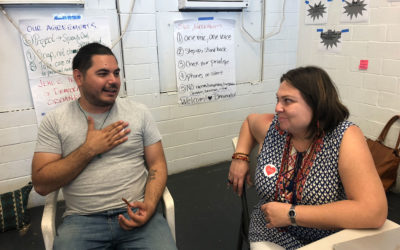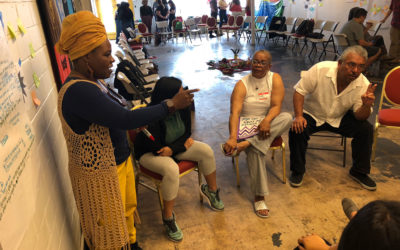Air
Air is sacred. Air is our breath. Air determines the state of our health. Air moves our lungs and replenishes our blood and organs. Air is thought and intellect. We live and move through air. Air has no boundaries, borders or limits. Air moves. Air seeks balance with water, earth and fire.
Carbon Pricing: Cap and Trade, Carbon Tax and Offsets
Carbon pricing is a term that was popularized by the World Bank to include carbon trading (cap-and-trade and offsets), carbon taxes, and voluntary carbon markets schemes. Carbon trading was introduced within the UN climate negotiations as a way to promote corporate-friendly measures and avoid regulations that could restrict polluting practices. This allowed corporations to secure additional profit through trading carbon credits. The idea behind carbon trading is to allow corporations to trade away their commitments of reducing emissions. The idea, so the theory goes, is to achieve an overall reduction in emissions through trading and offsetting pollution, rather than reducing extraction and pollution at source. The proponents argue that the free market will guide the process towards the cuts that are the cheapest to make.
Carbon pricing has a simple goal: to make it cheaper for governments and companies to meet emission reduction targets. However, this system is designed in such a way that the targets can be reached without actual emissions reductions taking place. The vested interests of corporate lobbies, polluting governments, financial institutions such as the World Bank, big conservation NGOs, among many others, have supported these schemes, not only to legitimize and expand a clearly unsustainable economic system based on extraction, but also as a source of further profit and land grabbing.
Cap and Trade
Under a cap and trade system, governments allot carbon permits (often each permit being equivalent to one tonne of carbon dioxide) to their major polluting industries. There is a set amount the industry is allowed to pollute (a cap). When a polluter finds that reducing emissions gets too expensive, it can buy permits from another polluter that can make ‘equivalent’ changes more cheaply (the trade). Industries exceeding their reduction commitments can sell their surpluses to those polluting above the cap.
Cap and trade systems have many loopholes in their design. Some of the key problems are:
- Carbon trading claims to set a ‘price signal’ that encourages polluters to switch to cleaner technologies. But carbon prices are (and will be) very volatile and prone to major crashes.
- Permits are sold by those with a surplus or excess.
- The trading part simply gives companies more maneuvering ability to escape addressing pollution; it does not reduce emissions.
- Chasing cheap and short-term reductions encourages quick ‘fixes’ to patch up outmoded power stations and factories – delaying any fundamental change.
Offsets
The second mechanism is based on the assumption that pollution in one location can be ‘offset’ by ‘saving emissions’ somewhere else. Offsets are another way that industries can buy their way out of having to limit their pollution levels (caps). Offsets have historically happened in the global South through the Kyoto Protocol, but there are many varying systems today everywhere on the planet. Implementing offset projects generates carbon credits that can be bought by the industries and used in a cap and trade system – offsets are part of a cap and trade scheme. Although offsets are often presented with several misleading terms like: emissions reductions, carbon neutral, or net zero emissions, they do not reduce emissions. Even in theory, they at most ‘compensate’ for the emissions somewhere else. However, research has demonstrated that the impact is double. First, the polluting industries pollute at higher levels than the cap because they can subtract their total emissions from offset credits and communities living next to these industries are impacted by more pollution. Second, the place where the offset project takes place – communities – are impacted as well. Research demonstrates how offset projects have negative impacts on communities’ livelihoods.
Cap And Invest, Cap And Dividend, Carbon Fee And Dividend, Cap and Fill-In-The-Blank
In the current carbon rhetoric, many of the above listed carbon trading systems are the same as a typical cap and trade system or a carbon tax. But the politicians and Big Greens pushing for a new and improved cap and fill-in-the-blank system promise financial gain to communities impacted by the polluting industry in an effort to silence and distort the truth – that carbon pricing systems keep fossil fuels coming out of the ground and impact communities of color and the poor and working classes living next to them. The communities they promise funding to are al Indigenous Peoples, People of Color communities, and poor and working class people. It is a divide-and-conquer tactic that pits communities against one another with the promise of some mythical, unending payment that will wipe away the pollution and repression and even being coined as reparation. But the small payments are a distraction from the reality of more pollution, more fossil fuels, more environmental injustice and more climate change.
“It is like cutting off the top of a blanket and sewing it on to the bottom.”
-Eva Blake, IEN, Boston Training, August 2019.
Carbon Taxes
Taxing the fossil fuel industry at extraction point has been done for decades. Fossil fuel taxes have never slowed or ended fossil fuel extraction. In the same way, carbon taxes will not slow or end polluting emissions. Here are some reasons why:
- Carbon taxes allow polluting industries to pass on the cost to consumers, impacting low-income communities first and most.
- Carbon taxes are ex post facto lock-in programs, meaning the revenue relies on fossil fuels coming out of the ground.
- There is zero evidence that demonstrates a carbon tax would drive up a carbon price high enough to shift investment to renewable energy systems. In fact, everything known about the current economic system points in the opposite direction.
- Carbon taxes are coupled into cap-and-trade systems
- Carbon taxes have been linked to carbon offset and REDD+ programs in the global South, massively impacting local community livelihoods and supporting extractive industries.
- Carbon taxes are supported by big polluting oil and coal corporations. They are not concerned about paying another tax because they have huge organizations to manage their finances and taxes for them.
Fossil fuel corporations receive trillions of dollars per year in subsidies. If a carbon tax gets too high, large corporations lobby for increased subsidies. It would be advantageous to campaign for an end to all fossil fuel subsidies and tax breaks before even mentioning a carbon tax.
Other Words To Look Out For:
- Net zero emissions
- Natural Climate Solutions
- Nature Based Solutions
Common Push Back from Proponents of Carbon Pricing
What They Say |
What We Say |
|
Cap and trade systems are a way to make polluters pay |
Cap and trade systems are a way for polluters to continue to pollute and make more profit |
|
Offsets are carbon neutral and allow for ‘carbon savings |
Offset programs allow polluting industries to pollute above their limit. They do nothing to support communities. Offsets harm communities both at the pollution site and the offset project site. |
|
Carbon taxes just make logical sense and drive the price of fossil fuels up so that they become less affordable and renewable energy become cheaper |
Carbon taxes pass on costs to consumers and do not impact a corporation’s bottom line. We should talk about phasing out fossil fuels immediately and addressing fossil fuel subsidies. |

Air: Responses and Resistance
Carbon Pricing and Labor by Irene HongPing Shen from Trade Unions for Energy Democracy (TUED) Carbon pricing has been promoted as an effective climate policy that would significantly reduce greenhouse gases (GHGs) throughout the world. Carbon pricing, including cap...
Workshop Sessions
Popular education activity guides for workshops and courses
Continuum Game
Time: 15-20 minutesLearning Style: Movement, oral, quick check-inObjective: This is a short game just to check where people are at on specific topics/concepts/problems. This exercise can be used to find out how much participants feel they know about a specific topic,...
Mingling Game
Time: 45-90 minutes. In one of the pilot trainings we spent a full two hours on this and went deep! Learning Style: Movement, group-building, ice breaking, oral, auditory and building confidence in group feedbackObjective: One objective is to use collective knowledge...
Trivia or Pub Quiz
Time: 1-2 hours Learning Style: Potentially all stylesObjective: This session uses humor and group-building by answering a series of trivia questions to win a prize at the end. This session can take place almost anywhere including in your local community space as part...





